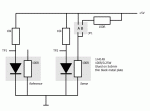Benm
0
- Joined
- Aug 16, 2007
- Messages
- 7,896
- Points
- 113
I have rigged a little setup with the thermal sensing idea - see picture for schematic.
This is just a proof of principe with some components i had around here, but it does demonstrate that it works, but with severe limitations.
The main problem is that the thermal mass of the sensor is so large it takes forever to get a stable readout - count on a minute or so. Looking at the schematic, you notice a resistor on the sensor plate. This is used to 'calibrate' the unit to some degree, as heating the sensor using the resistor does the same thing as heating it with a laser. Measuring between TP1 and TP2 using a multimeter, i got:
No laser, no jumper (i.e. zero) ~ -1.5 mV (due to tolerances in diodes and resitors)
JP1 position A, 5V/50mA=250mW: ~52mV.
JP2 position B 2.5v/25mA=63mW: ~ 12.9mV
According to the datasheet for the diode, it should result in about 2 mV/K response to heating up, which means 52mV ~ 26K temperature rise, or about 100 K/W for the whole sensor (sounds reasonable).
Notice that the schematic has 2 identical sensors, one exposed to the laser, one in the dark as reference. The reference sensor could be used in the future for better measurements, but for this series it could just have been any 1n4148 diode in the circuit.
This is just a proof of principe with some components i had around here, but it does demonstrate that it works, but with severe limitations.
The main problem is that the thermal mass of the sensor is so large it takes forever to get a stable readout - count on a minute or so. Looking at the schematic, you notice a resistor on the sensor plate. This is used to 'calibrate' the unit to some degree, as heating the sensor using the resistor does the same thing as heating it with a laser. Measuring between TP1 and TP2 using a multimeter, i got:
No laser, no jumper (i.e. zero) ~ -1.5 mV (due to tolerances in diodes and resitors)
JP1 position A, 5V/50mA=250mW: ~52mV.
JP2 position B 2.5v/25mA=63mW: ~ 12.9mV
According to the datasheet for the diode, it should result in about 2 mV/K response to heating up, which means 52mV ~ 26K temperature rise, or about 100 K/W for the whole sensor (sounds reasonable).
Notice that the schematic has 2 identical sensors, one exposed to the laser, one in the dark as reference. The reference sensor could be used in the future for better measurements, but for this series it could just have been any 1n4148 diode in the circuit.




